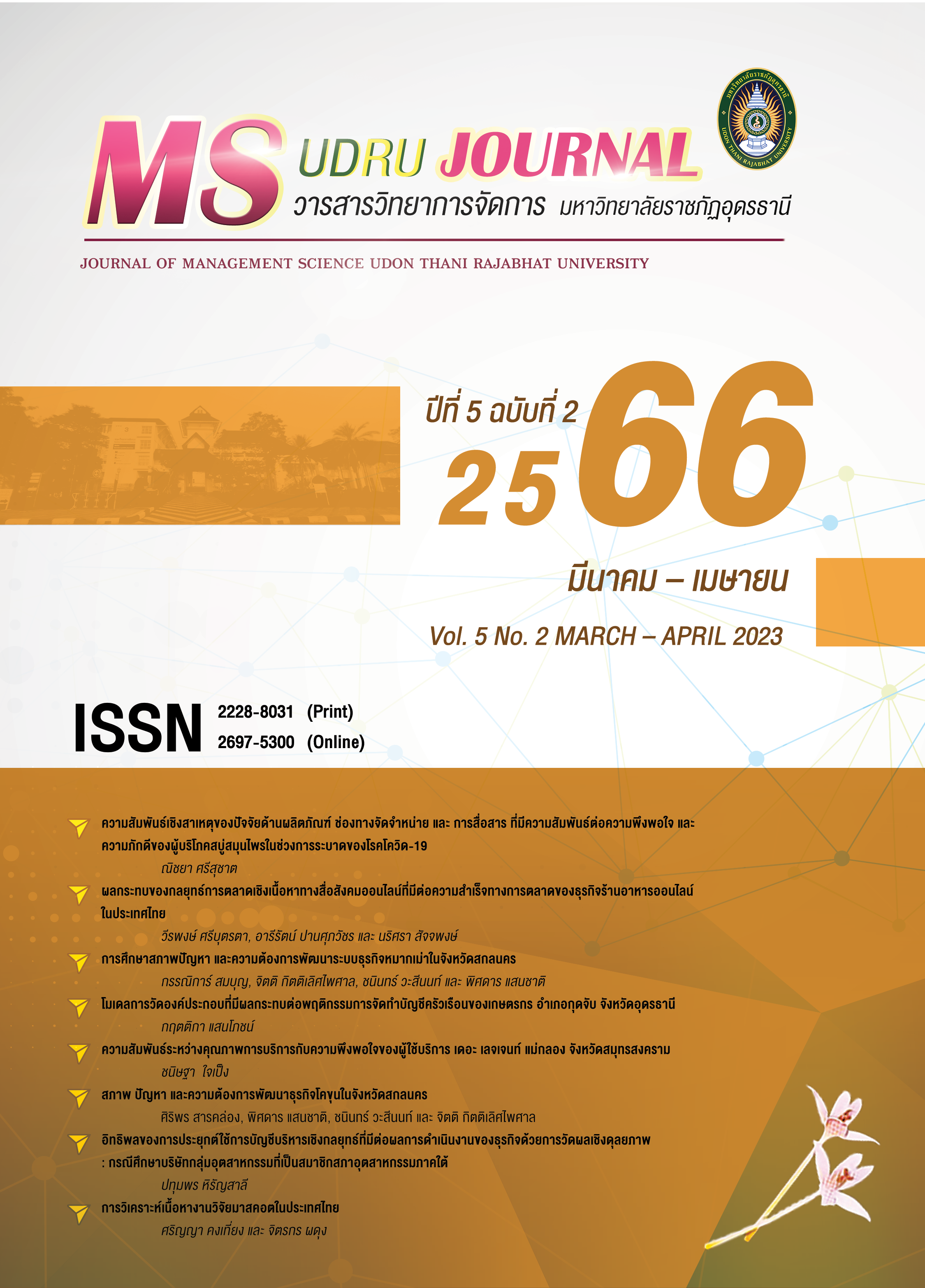THE CAUSAL RELATIONSHIP OF PRODUCT, DISTRIBUTION CHANNEL, AND COMMUNICATION FACTORS THAT RELATE TO SATISFACTION AND LOYALTY OF HERBAL SOAP DURING THE COVID-19 PANDEMIC
Main Article Content
Abstract
According to the COVID-19 crisis, the major shifts of consumer behavior, which was critical to business transformation worldwide, therefore the objectives of this research were to study the rational relationship and to create the causal model of product, distribution channel, and communication that relate to the satisfaction and loyalty of herbal soap consumers during the COVID-19 pandemic. The data were collected from 380 consumers of Bangkok area as a sample group during the COVID-19 pandemic, using confirmatory factor analysis, and Structural Equation Model analysis. The results of the relationship of product, distribution channel, and communication factors that relate to satisfaction and loyalty of herbal soap consumers during the COVID-19 pandemic revealed that product had relationship with the loyalty of herbal soap consumers during COVID-19 pandemic in a positive direction with correlation coefficient () = 0.662. Thus, the model of causal relationship of product and loyalty factors could be created and the product strategy could be brought to strategic planning in the epidemic context to develop soap products to fit with consumer purchasing demand by focusing on producing the soap product with no side effects on health, health benefit obtaining, and good quality.
Article Details

This work is licensed under a Creative Commons Attribution-NonCommercial-NoDerivatives 4.0 International License.
บทความที่ได้รับการตีพิมพ์เป็นลิขสิทธิ์ของคณะวิทยาการจัดการ มหาวิทยาลัยราชภัฏอุดรธานี
ข้อความที่ปรากฏในบทความแต่ละเรื่องในวารสารวิชาการเล่มนี้ ไม่ใช่ความคิดเห็นและความรับผิดชอบของผู้จัดทำ บรรณาธิการ กองบรรณาธิการ และคณะวิทยาการจัดการ มหาวิทยาลัยราชภัฏอุดรธานี ความรับผิดชอบด้านเนื้อหาและการตรวจร่างบทความแต่ละเรื่องเป็นความคิดเห็นของผู้เขียนบทความแต่ละท่าน
References
กรมพัฒนาการแพทย์แผนไทยและการแพทย์ทางเลือกกระทรวงสาธารณสุข. (2559). แผนแม่บทแห่งชาติว่าด้วยการพัฒนาสมุนไพรไทย ฉบับที่ 1 พ.ศ. 2560 – 2564. สืบค้นเมื่อ 18 พฤศจิกายน 2564 จาก http://www.dtam.moph.go.th/images/download/dl0021/MasterPlan-Thaiherb.pdf
กวิน มุสิกา และคณะ. (2556). ปัจจัยด้านผลิตภัณฑ์ และคุณค่าตราสินค้าที่ส่งผลต่อทัศนคติในตราสินค้าของเครื่องสำอางไทยใน สปป.ลาว (กลาง). วารสารวิทยาลัยพาณิชยศาสตร์บูรพาปริทัศน์, 8(2), 107-116.
กุลนันทน์ ศรีพงษ์พันธุ์. (2557). บทบาทของผลิตภัณฑ์ที่เน้นประโยชน์ใช้สอยและผลิตภัณฑ์เน้นความเพลิดเพลินทางอารมณ์ในงานวิจัย. วารสารบริหารธุรกิจ, 37(141), 34-47.
ชัยพร ศุภนิมิตวิเศษกุล และ ชวลีย์ ณ ถลาง. (2565). ปัจจัยส่วนประสมการตลาดการท่องเที่ยว ภายใต้วิกฤตโควิด 19. วารสารร่มพฤกษ์, 40(2). 70-88.
ไทยรัฐออนไลน์. (2557). แบ่ง กทม. 6 โซนให้ ส.ก.ดูแล. สืบค้นเมื่อ 18 พฤศจิกายน 2564, จาก https://www.thairath.co.th/news/local/bangkok/461318
ธานินทร์ ศิลป์จารุ. (2555). การวิจัยและวิเคราะห์ข้อมูลทางสถิติด้วย SPSS และ AMOS. พิมพ์ครั้งที่ 13. กรุงเทพฯ : บิสซิเนสอาร์แอนด์ดี.
นิเวศน์ ธรรมะ (2562). ประสบการณ์การซื้อออนไลน์ที่ส่งผลต่อความตั้งใจซื้อสินค้าออนไลน์. วารสารรังสิตบัณฑิตศึกษาในกลุ่มธุรกิจและสังคมศาสตร์, 5(1), 62-71.
ประชาชาติธุรกิจ. (2560). สบู่ 1.4 หมื่นล้านคึกแบรนด์ยักษ์ชิง “สมุนไพร”. สืบค้นเมื่อ 18 พฤศจิกายน 2564, จาก https://www.prachachat.net/marketing/news-57482.
ผู้จัดการออนไลน์. (2563). นีลเส็นชี้หลังโควิด-19 จบ จับตาคนไทยเปลี่ยนหลายอย่าง. สืบค้นเมื่อ 18 พฤศจิกายน 2564, จาก https://mgronline.com/business/detail/9630000039667.
พรทิพย์ ทองอ่อน. (2559). ความสัมพันธ์ระหว่างทัศนคติรูปลักษณ์ผลิตภัณฑ์ ต่อความตั้งใจซื้อผลิตภัณฑ์เครื่องสำอางสมุนไพร OTOP ของผู้บริโภค ในเขตพื้นที่จังหวัดตรัง. วิทยานิพนธ์ ปริญญาบริหารธุรกิจมหาบัณฑิต สาขาบริหารธุรกิจ มหาวิทยาลัยสงขลานครินทร์.
พรรณิภา วิชัยพล, สุรินทร์ มรรคา และตะวัน วิกรัยพัฒน์ (2564). การศึกษาปัจจัยส่วนประสมทางการตลาดผลิตภัณฑ์สบู่สมุนไพรไทยของผู้บริโภคในเขตวังทองหลาง กรุงเทพมหานคร. วารสารรัชต์ภาคย์. 15(41), 273-282.
พัสกร ลี้วิศิษฏ์พัฒนา และอนงค์ ศรีโสภา. (2563). การเลือกซื้อผลิตภัณฑ์ชุมชนประเภทสบูู่สมุนไพรผ่านส่วนประสมทางการตลาด. Rajabhat Journal of Sciences, Humanities and Social Sciences, 21(1), 55-68.
วรเศรษฐ์ สุพรรณพงศ์ และ ตรีเนตร ตันตระกูล. (2563). อิทธิพลของตลาดพาณิชย์อิเล็กทรอนิกส์กับพฤติกรรมซื้อสบู่สมุนไพรออนไลน์. วารสารสังคมศาสตร์และมานุษยวิทยาเชิงพุทธ, 5(7), 328-344.
สถาบันวิจัยเพื่อการพัฒนาประเทศไทย. (2563). ปัญหาการกักตุนสินค้าจำเป็นในช่วงวิกฤติการโควิด-19. สืบค้นเมื่อ 3 มกราคม 2564, จาก https://tdri.or.th/2020/02/covid-2/.
Anas, M., Khan, M.N., Rahman, O. and Uddin, S.M.F. (2022). "Why consumers behaved impulsively during COVID-19 pandemic?", South Asian Journal of Marketing, 3(1), 7-20.
Bangkokpost. (2020). Nielsen: FMCG pick up pace in pandemic. Retrieved November 18, 2021, from https://www.bangkokpost.com/business/1894595/nielsen-fmcg-pick-up-pace-in-pandemic.
Di Crosta, A., Ceccato, I., Marchetti, D., La Malva, P., Maiella, R., Cannito, L., Cipi, M., Mammarella, N., Palumbo, R., Verrocchio, M.C., Palumbo, R. & Di Domenico, A. (2021). Psychological factors and consumer behavior during the COVID-19 pandemic. PLoS ONE, 16(8): e0256095.
Despin T. (2020). Knock-on effects of COVID-19 on consumer behavior and how businesses can prepare for them. Retrieved September 1, 2022 from https://www.entrepreneur.com/article/350457.
Ernst & Young. (2020). Beyond Covid-19, what define the new normal. Retrieved September 1, 2022 from https://assets.ey.com/content/dam/ey-sites/ey-com/fi_fi/pdf/beyond-covid-19-what-will-define-the-new-normal.pdf.
Hair, J. F., Black, W. C., Babin, B. J. & Anderson, R. E. (2010). Multivariate data analysis. (7th ed.). Upper Saddle River, NJ: Prentice Hall.
Jaijid, M. (2017). Factors relationships with a customer loyalty of home-improvement modern trade store in Bangkok Metropolitan region. Panyapiwat Journal, 9(2), 1-11.
Kirishnan, A., & Nandhini, M.(2017). Factors Affecting the Purchasing Behaviour of Consumers in Ernakulam District with Special Emphasis on Bathing Soap. International Journal of Research in Arts and Science, 3(special issue), 11-15.
Kotler, P. & Armstrong, G. (2018). Principle of marketing. United Kingdom: Pearson.
Kotler, P. (2009). Marketing management. (13th ed). New Jersey: Prentice-Hell.
Kotler, P. Kartajaya, H., & Setiawan, I. (2017). Marketing 4.0. New Jersey: John Wilwy & Sons, Inc.
Mintel. (2021). Local pride: 51% of Thais say buying local products is an efficient way to boost the nation's economy. Retrieved November 18, 2021, from https://www.mintel.com/press-centre/social-and-lifestyle/51-of-thais-say-buying-local-products-is-an-efficient-way-to-boost-the-nations-economy.
Richard, M. O., & Chebat, J. C. (2016). Modeling online consumer behavior: Preeminence of emotions and moderating influences of need for cognitionand optimal stimulation level. Journal of Business Research, 69, 541–553.
Schiffman,L.G. & Wisenblit, J.L. (2015). Consumer behavior. United Kingdom: Pearson.
Shaari, H. (2020). Assessing brand health during COVID-19 pandemic: FMCGS brand loyalty in Malaysia. Journal of Critical Reviews, 7(8), 1623-1630.
U-on, V. (2014). The theory of consumer behavior. Retrieved November 18, 2020 from http://poundtv5.blogspot.com/2014/10/theory-of-consumer-behavior.html.


